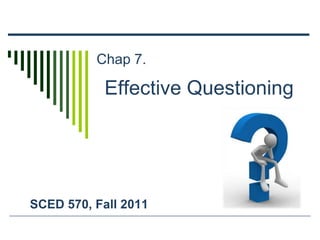Chapter 7 questioning
•Download as PPTX, PDF•
2 likes•747 views
Report
Share
Report
Share

Recommended
More Related Content
What's hot
What's hot (19)
Critical Thinking, Problem Solving, Decision Making

Critical Thinking, Problem Solving, Decision Making
Evaluating an Instructional Sequence with Interactive Simulations (ISIS)

Evaluating an Instructional Sequence with Interactive Simulations (ISIS)
Viewers also liked
Viewers also liked (6)
Similar to Chapter 7 questioning
Indicates reasons why distance education instruction should entice on-line critical thinking.10 Effective Methods: Infusing Critical Thinking in Online Education

10 Effective Methods: Infusing Critical Thinking in Online EducationNova Southeastern University Abraham S. Fischler School of Education
Faculty Training - Lesson Planning for Interactive Learning 

Faculty Training - Lesson Planning for Interactive Learning Fairway Independent Mortgage Corporation
Similar to Chapter 7 questioning (20)
Handout -critical_thinking_-_teaching_methods_and_strategies (1)

Handout -critical_thinking_-_teaching_methods_and_strategies (1)
Preparing to Teach 3: Supporting expert-like thinking

Preparing to Teach 3: Supporting expert-like thinking
Using discussion forums to enhance critical thinking

Using discussion forums to enhance critical thinking
10 Effective Methods: Infusing Critical Thinking in Online Education

10 Effective Methods: Infusing Critical Thinking in Online Education
Using discussion forums to engage students in critical thinking

Using discussion forums to engage students in critical thinking
Faculty Training - Lesson Planning for Interactive Learning 

Faculty Training - Lesson Planning for Interactive Learning
More from Kristin Eaquinto
More from Kristin Eaquinto (16)
Chapter 3 conceptual understanding alternative conceptions

Chapter 3 conceptual understanding alternative conceptions
Chapter 3 conceptual understanding alternative conceptions

Chapter 3 conceptual understanding alternative conceptions
Chapter 3 conceptual understanding alternative conceptions

Chapter 3 conceptual understanding alternative conceptions
Recently uploaded
https://app.box.com/s/7hlvjxjalkrik7fb082xx3jk7xd7liz3TỔNG ÔN TẬP THI VÀO LỚP 10 MÔN TIẾNG ANH NĂM HỌC 2023 - 2024 CÓ ĐÁP ÁN (NGỮ Â...

TỔNG ÔN TẬP THI VÀO LỚP 10 MÔN TIẾNG ANH NĂM HỌC 2023 - 2024 CÓ ĐÁP ÁN (NGỮ Â...Nguyen Thanh Tu Collection
Mehran University Newsletter is a Quarterly Publication from Public Relations OfficeMehran University Newsletter Vol-X, Issue-I, 2024

Mehran University Newsletter Vol-X, Issue-I, 2024Mehran University of Engineering & Technology, Jamshoro
Recently uploaded (20)
Unit-IV; Professional Sales Representative (PSR).pptx

Unit-IV; Professional Sales Representative (PSR).pptx
TỔNG ÔN TẬP THI VÀO LỚP 10 MÔN TIẾNG ANH NĂM HỌC 2023 - 2024 CÓ ĐÁP ÁN (NGỮ Â...

TỔNG ÔN TẬP THI VÀO LỚP 10 MÔN TIẾNG ANH NĂM HỌC 2023 - 2024 CÓ ĐÁP ÁN (NGỮ Â...
ICT Role in 21st Century Education & its Challenges.pptx

ICT Role in 21st Century Education & its Challenges.pptx
Basic Civil Engineering first year Notes- Chapter 4 Building.pptx

Basic Civil Engineering first year Notes- Chapter 4 Building.pptx
Python Notes for mca i year students osmania university.docx

Python Notes for mca i year students osmania university.docx
Food Chain and Food Web (Ecosystem) EVS, B. Pharmacy 1st Year, Sem-II

Food Chain and Food Web (Ecosystem) EVS, B. Pharmacy 1st Year, Sem-II
General Principles of Intellectual Property: Concepts of Intellectual Proper...

General Principles of Intellectual Property: Concepts of Intellectual Proper...
Measures of Central Tendency: Mean, Median and Mode

Measures of Central Tendency: Mean, Median and Mode
Chapter 7 questioning
- 1. Chap 7. Effective Questioning SCED 570, Fall 2011
- 2. Questioning: an essential tool Strategic questioning: selecting and using specific types of questions. Researchers have created a variety of ways to categorize types of questions: Bloom’s Taxonomy Socratic Questioning Productive questions (Martens, 1999) Blosser’sQuestion Category System for Science (QCSS, 1973)
- 3. Bloom’s Taxonomy Knowledge Comprehension Application Analysis Synthesis Evaluation
- 4. Socratic Questioning conceptual clarification questions(Why are you saying that? What exactly does this mean? ) probing assumptions (How can you verify or disprove that assumption? What would happen if ... ? ) probing rationale, reasons and evidence (What do you think causes ... ? What is the nature of this? ) questioning viewpoints and perspectives (Why it is ... necessary? Who benefits from this? ) probe implications and consequences (What are the implications of ... ? How does ... affect ... ? ) questions about the question (Why do you think I asked this question?What does that mean? ) From http://changingminds.org/techniques/questioning/socratic_questions.htm
- 5. QCSS (Blosser, 1973) Closed Questions Memory Convergent thinking Open (open-ended) Questions Evaluative Divergent thinking Managerial Rhetoricalhttp://www.narst.org/publications/research/question.cfm
- 6. Types of Questions Research reveals a high frequency of basic questioning in the classroom: Rhetorical – “Are we all here?” “Read-it-and-repeat-it” Lower level thinking without further development More open-ended questions: More thoughtful responses Stimulate discussion
- 7. Inquiry & Questioning Questioning can lead to deeper inquiry experiences. “feedback loop” 1- Teachers ask questions to elicit levels of student understanding 2- Students respond- orally, diagram, drawings 3- Teachers recognize and acknowledge student responses. 4- Teachers provide scaffolds to improve learning and understanding.
- 8. Inquiry & Questioning 5-E Model Table 7-1 (p. 188)Engage- Initiate InquiryExplore- Guide Discussions of ObservationsExplain- Guide Discussions of ExplanationsElaborate- Guide Discussions of Applications to New Situations Questions to promote inquiry http://tlc.ousd.k12.ca.us/~acody/inquiryquery.html
- 9. Respond to students (Table 7-2 p.195) Accept student responses Acknowledge, reinforce, repeat Establish safe learning environment Extend student responses Build on, compare, apply, summarize Probe student responses Go beyond superficial responses Build on ideas, clarify, justify, verify
- 10. Final thoughts Questions need to serve a purpose and reflect a genuine intent to promote learning. Wait time supports processing, increases participation, positive for students. Fade teachers’ questioning support; develop students’ metacognition Broaden questioning repertoire Support critical thinking skills Support inquiry in the science classroom